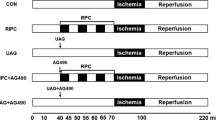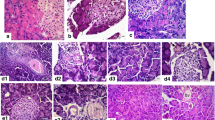Abstract
Background
No published study has addressed the effect of genistein postconditioning on gastric ischemia–reperfusion (GI–R) injury in rats.
Aim
To examine whether capsaicin receptor-mediated genistein postconditioning protects against gastric ischemia–reperfusion injury via the PI3K/Akt signal pathway.
Methods and Results
Chloraldurat-anesthetized rats underwent occlusion of the celiac artery for 30 min, followed by 60 min of reperfusion. Based on this animal model of gastric ischemia–reperfusion injury, genistein at doses of 100, 500 or 1,000 μg/kg was administered via peripheral vein 5 min before reperfusion. The dose of 500 μg/kg was optimal for postconditioning, at which the severity of I–R-induced gastric injury significantly decreased. Immunohistochemistry also showed that gastric mucosal cell apoptosis decreased. Capsazepine (CPZ), a specific antagonist for the capsaicin receptor, was administered (1,000 μg/kg, i.v.) just before ischemia. Capsaicin (50 mg/kg, s.c.) once a day for 4 days reversed the protective effects of genistein. Reverse transcription-polymerase chain reaction (RT-PCR) and Western blotting showed increased calcitonin gene-related peptide (CGRP) expression in genistein group but not in capsazepine or capsaicin group. CGRP inhibitor CGRP8-37 also prevented the effects of genistein in decreasing gastric mucosal injury index. In addition, PI3K inhibitor LY294002 (1.5 mg/kg) reversed the protective effect of genistein. Compared with genistein group, Western blots also demonstrated decreased Akt phosphorylation in LY294002 group.
Conclusion
Our data suggest that capsaicin receptors mediated the protective effects of genistein postconditioning. CGRP secreted by activated capsaicin-sensitive neurons played an important role in the protective effects of genistein. PI3K/Akt pathway was also involved in the protective effects of genistein.








Similar content being viewed by others
References
Souzeau E, Belanger S, Picard S, et al. Dietary isoflavones during pregnancy and lactation provide cardio protection to offspring rats in adulthood. Am J Physiol Heart Circ Physiol. 2005;289:H715–H721.
Walker HA, Dean TS, Sanders TA, et al. The phytoestrogen genistein produces acute nitric oxide-dependent dilation of human forearm vasculature with similar potency to 17beta-estradiol. Circulation. 2001;103:258–262.
Rishi RK. Phytoestrogens in health and illness. Indian J Pharmacol. 2002;34:311–320.
Jiang F, Jones GT, Husband AJ. Cardiovascular protective effects of synthetic isoflavone derivatives in apolipoprotein E-deficient mice. J Vasc Res. 2003;40:276–284.
Ji ES, Yue H, Wu YM. Effects of phytoestrogen genistein on myocardial ischaemia-reperfusion injury and apoptosis in rabbits. Acta Pharmacol Sin. 2004;25:306–312.
Amira S, Rotondo A, Mulè F. Relaxant effects of flavonoids on the mouse isolated stomach: structure-activity relationships. Eur J Pharmacol. 2008;599:126–130.
Takekawa S, Matsui T, Arakawa Y. The protective effect of the soybean polyphenol genistein against stress-induced gastric mucosal lesisons in rats, and its hormonal mechanisms. J Nutr Sci Vitaminol. 2006;52:274–280.
Purcell AL, Carew TJ. Modulation of excitability in Aplysia tail sensory neurons by tyrosine kinases. J Neurophysiol. 2001;85:2398–2411.
Linford NJ, Dorsa DM. 17beta-Estradiol and the phytoestrogen genistein attenuate neuronal apoptosis induced by the endoplasmic reticulum calcium-ATPase inhibitor thapsigargin. Steroids. 2002;67:1029–1040.
Ward SM, Bayguinov J, Won KJ, et al. Distribution of the vanilloid receptor (VR1) in the gastrointestinal tract. J Comp Neurol. 2003;465:121–135.
Patterson LM, Zheng H, Ward SM, et al. Vanilloid receptor (VR1) expression in vagal afferent neurons innervating the gastrointestinal tract. Cell Tissue Res. 2003;311:277–287.
Sasamnra T, Kuraishi Y. Peripheral and central actions of capsaicin and VR1 receptor. Jpn J Pharmacol. 1999;80:275–280.
Faussone-Pellegrini MS, Taddei A, Bizzoco E, et al. Distribution of the vanilloid (capsaicin) receptor type 1 in the human stomach. Histochem Cell Biol. 2005;124:61–68.
Kang JY, Teng CH, Chen FC, et al. Effect of capsaicin and cimetidine on the healing of acetic acid induced gastric ulceration in the rat. Gut. 1996;38:832–836.
Holzer P. Efferent-like roles of afferent neurons in the gut: Blood flow regulation and tissue protection. Auton Neurosci. 2006;125:70–75.
Kwiecien S, Brzozowski T, Konturek PC, et al. The role of reactive oxygen species and capsaicin-sensitive sensory nerves in the pathomechanisms of gastric ulcers induced by stress. J Physiol Pharmacol. 2003;54:423–437.
Osaki M, Kase S, Adachi K, et al. Inhibition of the PI3K-Akt signaling pathway enhances the sensitivity of Fas-mediated apoptosis in human gastric carcinoma cell line, MKN-45. J Cancer Res Clin Oncol. 2004;130:8–14.
Plastaras JP, Dorsey JF, Carroll K, et al. Role of PI3K/Akt signaling in TRAIL- and radiation-induced gastrointestinal apoptosis. Cancer Biol Ther. 2008;7:2047–2053.
Wada K, Kamisaki Y, Kitano M, et al. A new gastric ulcer model induced by ischaemia-reperfusion in the rat: role of leukocytes on ulceration in rat stomach. Life Sci. 59:PL295–PL301.
Guth PH, Aures D, Poulsen G. Topical aspirin plus HCl gastric lesions in the rat. Cytoprotective effect of prostaglandin, cimetidine and probanthine. Gastroenterology. 1979;76:88–93.
Towbin H, Staehelin T, Gordon J, et al. Electrophoretic transfer of proteins from polyacrylamide gels to nitrocellulose sheets: procedure and some applications. Proc Natl Acad Sci USA. 1979;76:4350–4354.
Farber JL, Chien KR, Mittnacht S Jr. Myocardial ischaemia: the pathogenesis of irreversible cell injury in ischaemia. Am J Pathol. 1981;102:271–281.
Cheung JY, Bonventre JV, Malis CD, et al. Calcium and ischemic injury. N Engl J Med. 1986;314:1670–1676.
Piper HM, Meuter K, Schafer C, et al. Cellular mechanisms of ischaemia reperfusion injury. Ann Thorac Surg. 2003;75:S644–S668.
Zhao ZQ, Corvera JS, Halkos ME, et al. Inhibition of myocardial injury by ischemic postconditioning during reperfusion: comparison with ischemic preconditioning. Am J Physiol Heart Circ Physiol. 2003;285:H579–H588.
Kin H, Zhao ZQ, Sun HY, et al. Postconditioning attenuates myocardial ischaemia-reperfusion injury by inhibiting events in the early minutes of reperfusion. Cardiovasc Res. 2004;62(1):74–85.
Sun K, Liu ZS, Sun Q. Role of mitochondria in cell apoptosis during hepatic ischaemia- reperfusion injury and protective effect of ischemic postconditioning. World J Gastroenterol. 2004;10:1934–1938.
Akiyama T, Ishida J, Nakagawa S, et al. Genistein, a specific inhibitor of tyrosine-specific protein kinases. J Biochem. 1987;262:5592–5595.
Deodato B, Altavilla D, Squadrito G. Cardioprotection by the phytoestrogen genistein in experimental myocardial ischaemia-reperfusion injury. Br J Pharmacol. 1999;128:1683–1690.
Tissier R, Waintraub X, Couvreur N. Pharmocological postconditioning with the phytoestrogen genistein. J Molecul Cellul Cardiol. 2007;42:79–87.
Cesare P, Moriondo A, Vellani V. Ion channels gated by heat. Proc Natl Acad Sci. 1999;96:7658–7663.
Katoa S, Aihara E, Nakamura A, et al. Expression of vanilloid receptors in rat gastric epithelial cells: role in cellular protection. Biochem Pharmacol. 2003;66:1115–1121.
Ren YS, Ma TG, Wang HB, et al. Protective effects of calcitonin gene-related peptide (CGRP) on myocardial cell injury and magnesium contents following severe hypoxia and simulated reperfusion. Med Sci Res. 1993;21:177–178.
Li YJ, Peng CF, Li NS, et al. Calcitonin gene-related peptide protects against endothelial cell damage due to oxidized low-density lipoprotein. Med Sci Res. 1993;23:253–254.
Li YJ, Peng J. The cardioprotection of calcitonin gene-related peptide mediated preconditioning. Eur J Pharmacol. 2002;442:173–177.
Shimozawa N, Okajima K, Harada N, et al. Estrogen and isoflavone attenuate stress-induced gastric mucosal injury by inhibiting decreases in gastric tissue levels of CGRP in ovariectomized rats. Am J Physiol Gastrointest Liver Physiol. 2007;292:G615–G619.
Franke TF, Hornik CP, Segev L, et al. Sugimoto C: PI3K/Akt and apoptosis: size matters. Oncogene. 2003;22:8983–8998.
Shibata M, Yamawki T, Sasaki T. Upregulation of Akt phosphorylation at the early stage of middle cerebral artery occlusion in mice. Brain Res. 2002;942:l–l10.
Matsui T, Tao J, del Monte F, et al. Akt activation preserves cardiac function and prevents injury after transient cardiac ischaemia in vivo. Circulation. 2001;104:330–335.
Xing C, Zhu B, Liu H, et al. Class I phosphatidylinositol 3-kinase inhibitor LY294002 activates autophagy and induces apoptosis through p53 pathway in gastric cancer cell line SGC7901. Acta Biochim Biophys Sin. 2008;40:194–201.
Acknowledgments
This project was supported by grants from the National Natural Science Foundation of China (no. 30570671) and the Xuzhou Social Development Fund (no. XMD8C062). The authors are grateful for this financial support.
Conflict of interest statement
There is no conflict of interest.
Author information
Authors and Affiliations
Corresponding author
Additional information
Xiao-Bo Ma and Dong-Shu Du are co-first authors.
Rights and permissions
About this article
Cite this article
Du, DS., Ma, XB., Zhang, JF. et al. The Protective Effect of Capsaicin Receptor-Mediated Genistein Postconditioning on Gastric Ischemia–Reperfusion Injury in Rats. Dig Dis Sci 55, 3070–3077 (2010). https://doi.org/10.1007/s10620-010-1151-3
Received:
Accepted:
Published:
Issue Date:
DOI: https://doi.org/10.1007/s10620-010-1151-3




